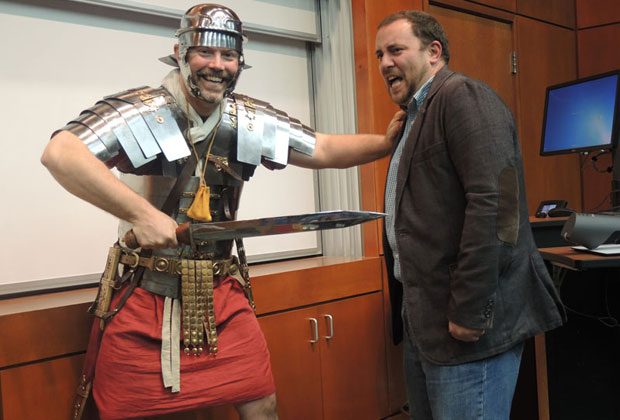Life as a Roman soldier

In modern times, many view the Roman soldier as an elite killing machine, a well-drilled and trained warrior, a picture of power and strength.
Those assumptions are accurate, according to Professor Jonathan Zarecki, a professor of Classis at the University of North Carolina at Greensboro and an expert on Roman times. But the soldiers, who conquered much of Europe and Egypt, were humans too.
Donning authentic Roman armor, Zarecki told a story last Thursday at Furman of a legionary who died in a battle, and his brother’s attempt to get his body home.
“The inscription here says he died in this war, and if it will be permitted to intern his bones here, not it is permitted, but it will be. As in, if you find them, please bring them home so his brother can bury him. If nothing else I like to show this as proof that Roman soldiers were actually people, with families who cared about them and not automatons made from the spare body parts of dead legionnaires.”
In a lecture titled “The Real Life of a Roman Soldier: All Work and No Play Makes Gaius an Invincible Killing Machine,” Zarecki described the typical Roman army life, referring to it as being a very exclusive club.
“So how did one actually become a Roman soldier? Would you like to become a member of the Roman Army? Of course you would. Let’s see who would have actually been able to join.”
To illustrate his point, he called for everyone in the room to rise, ticking off criteria and then allowing students who would be ineligible to serve in the army time to sit.
“First off you must be male. You must also be unmarried. You had to have citizenship. Have any physical limitations, bad hearing, bad eyesight? Anybody with glasses? Goodbye. You couldn’t be out of shape. You had to be at least 5 foot 10 inches tall. But if you had a lively eye, an erect chest and broad shoulders, long fingers, strong arms, a small waist, and legs without a lot of fat on them, then they may have made an exception for you.”
According to Zarecki, the process created uniformity among the soldiers. Every part of the legion’s physical training was dedicated to creating the perfect individual soldier who would mesh seamlessly with others to form the terror that was the Roman Army. It was this particular ideology, and the Roman’s training tactics that allowed them to triumph over their enemies.
“A legionnaire’s training continued throughout his time in the legion. You didn’t reach some standard of fitness that exempted you from other things. Training was heavily regimented and exceedingly repetitive,” he said. “Soldiers were put through a gauntlet of physical and mental tests before they were ever able to use a sword. The training exposed his mind and body to every possible hardship and prepared him to execute military feats.”
Every aspect of Roman training was meant to make battle a place where soldiers did not have to think to survive; it was instinctive instead. Upon completion of training, soldiers would be capable, efficient, war machines. A life of constant drills, assuming you weren’t killed before the end of your term, meant you could leave the army after your mandatory 25 years of service.
There were many kinds of discharges which could prove to benefit or harm, including one which expressed the opinion of the army that you were “a failure as a human being.” Nonetheless, that did not deter many from willingly enlisting; despite the awareness of the hardships they would face in order to achieve the coveted title of Roman soldier.